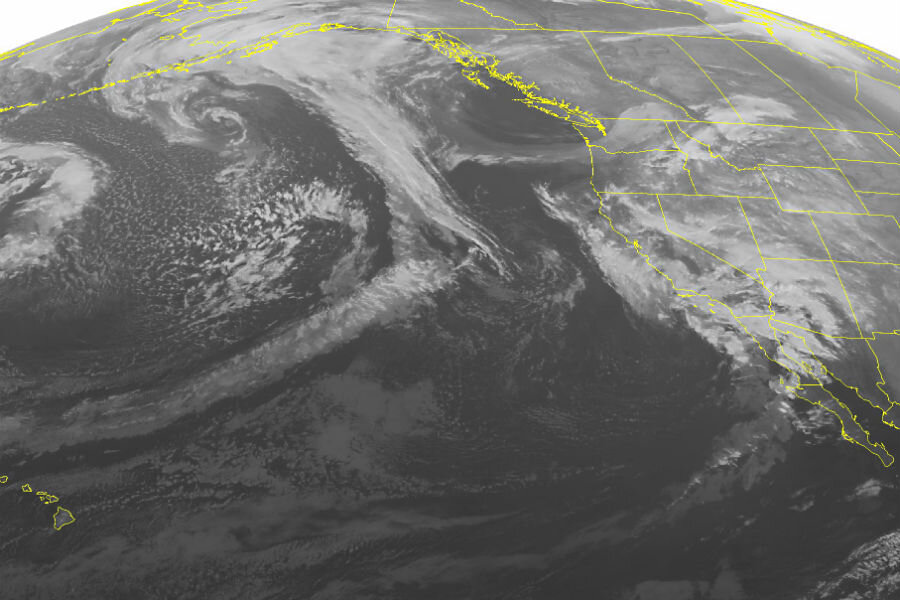El Niño effect: California preps for two weeks of rain and snow
Loading...
| San Francisco
After all the talk, El Niño storms have finally lined up over the Pacific and started soaking drought-parched California with rain expected to last for most of the next two weeks, forecasters said Monday.
On Tuesday, a strong storm was forecast for northern California, prompting officials to issue flash flood watches for several rural areas hit by last year's wildfires.
As much as 15 inches of rain could fall in the next 15 days in northern California, with about 2 feet of snow expected in the highest points of the Sierra Nevada, said Johnny Powell, a forecaster with the National Weather Service.
To the south, persistent wet conditions could put some Los Angeles County communities at risk of flash-flooding along with mud and debris flows, especially in wildfire burn areas.
The brewing El Niño system — a warming in the Pacific Ocean that alters weather worldwide — is expected to impact California and the rest of the nation in the coming weeks and months.
Its effects on California's four-year drought are difficult to predict, but Jet Propulsion Laboratory climatologist Bill Patzert said it should bring some relief.
El Ninos in the early 1980s and late 1990s brought about twice as much rain as normal, he said. The weather also caused mudslides, flooding and high surf.
As The Christian Science Monitor reported last month, the National Oceanic and Atmospheric Administration and the California Department of Water estimate that the storms from this year’s El Niño would need to bring 60 inches more rain over the average, and provide 39 inches of snow water content, in order to help bring California into drought recovery.
Initial satellite observations from NASA appear to indicate that the atmospheric rivers, or narrow corridors of concentrated moisture, that occur during El Niño may provide some relief from the drought. Atmospheric rivers are typically responsible for the patterns of extreme rainfall and flooding that occur in the mid-latitude, westerly coastal regions of the world, like the west coasts of North America, Europe, and Africa.
"Over a 25-year period, over the long term, El Niño provides only 7% of our water. So as much as we’re hyping it, it’s not a big player," Bill Patzert, a climatologist with NASA’s Jet Propulsion Laboratory in La Cañada Flintridge, told the Los Angeles Times. "It’s fast and furious, but it’s too irregular – the gap between El Niños is too long to [point to it as a] drought-buster.”
But experts predict that while El Niño may help alleviate the symptoms of the drought, it will not help eliminate the problem completely.
In recent weeks, a weather pattern partly linked with El Niño has turned winter upside-down across the nation, bringing spring-like warmth to the Northeast, a risk of tornadoes in the South, and so much snow across the West that even ski slopes have been overwhelmed.
Big parts of the country are basking in above-average temperatures, especially east of the Mississippi River and across the Northern Plains.
The record drought in California has forced Gov. Jerry Brown to order cities to conserve water by 25 percent compared to the same period in 2013.
While forecasters say a strong El Nino weather system could drench the state, one good, wet winter won't be enough to rehydrate parched land.
In Los Angeles County foothills beneath wildfire burn areas, residents braced Monday for possible flash flooding and debris flows. Workers in Azusa cleared storm drains and handed out sandbags, while in nearby Glendora, police announced restricted parking measures for steep roadways under barren hillsides.
Residents were urged to monitor weather reports and consider stockpiling sand bags.
Los Angeles Mayor Eric Garcetti warned people to clear gutters and anything in their yard that might clog storm drains; assemble an emergency kit; and stockpile sandbags if their home is susceptible to flooding.
An effort also was under way to provide shelter for homeless people.
"We want as little damage and destruction and as little death as possible," Garcetti said.
Between 2 and 3.5 inches of rain is predicted to fall across the coastal and valley areas of Southern California through Friday, with up to 5 inches falling in the mountains.
The first wave of rain started in Northern California with light showers Sunday and was expected to pick up strength and cover a large area of the region, the weather service said.
"This series of storms are definitely associated with the El Niño phenomenon in that the jet stream has taken a fairly significant southward trajectory in the Pacific on its return flow back into the California coastline," said Bob Benjamin, a forecaster with the weather service.
Forecasters say a second, stronger storm is expected to arrive in Northern California late Monday. At least two more storms are expected to follow on Wednesday and Thursday, possibly bringing as much as 3 inches of rain.
"Friday looks like a dry, clear day but more rain is expected Saturday," Powell said.
In Arizona, El Nino conditions will help push a parade of Pacific Ocean storms inland with light to moderate snow falling in the high country and rain in lower elevations, forecasters said Monday.
The National Weather Service says a series of weather systems will drop snow in the high country and rain in lower elevations as the week progresses.
___
Associated Press writers Christopher Weber in Los Angeles and Paul Davenport in Phoenix contributed to this report.







